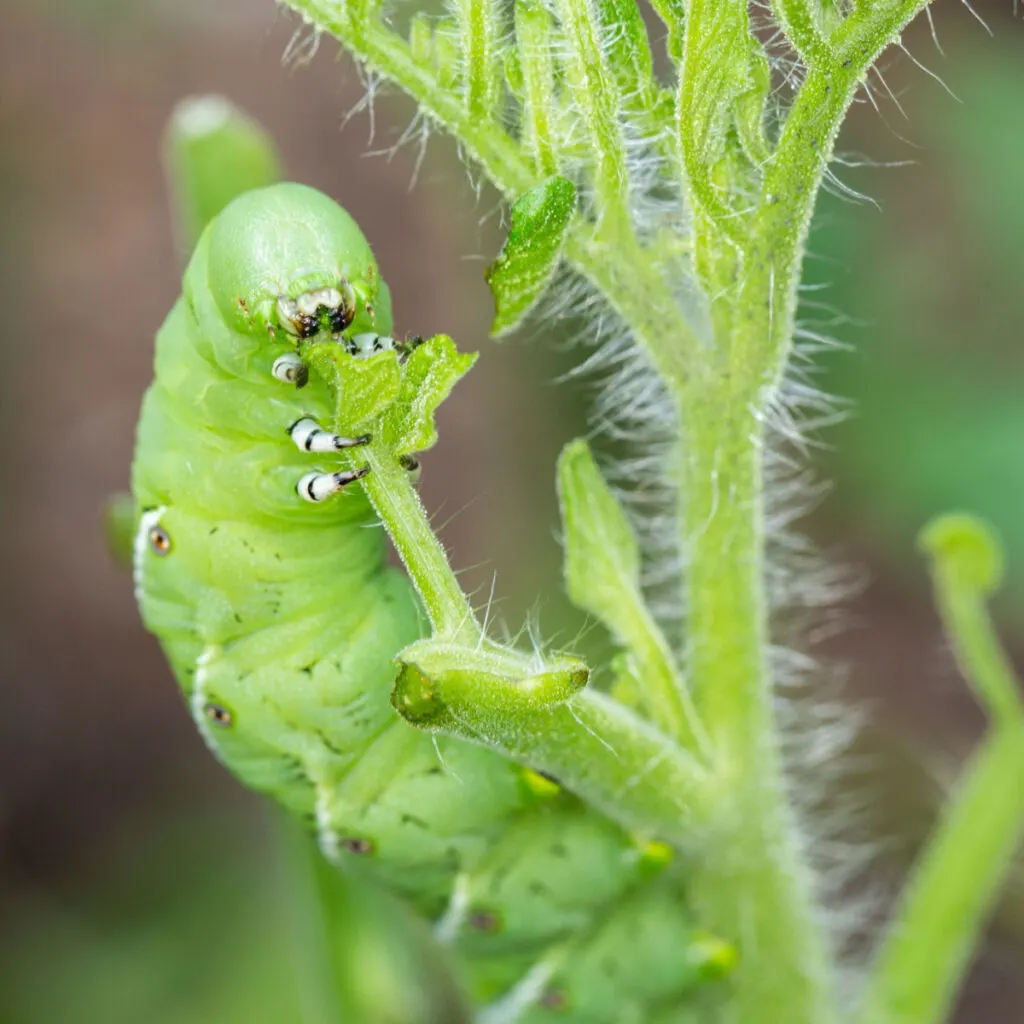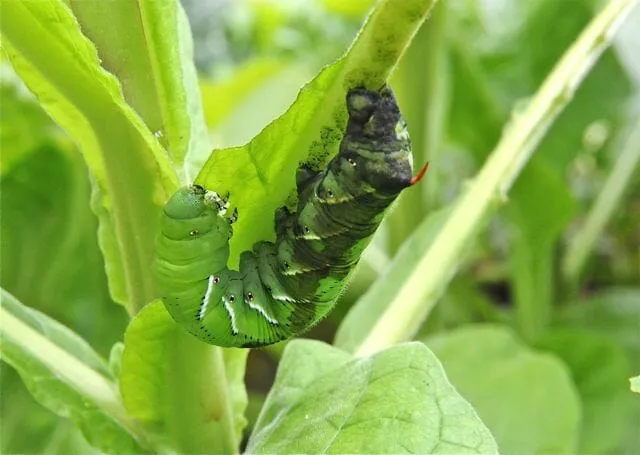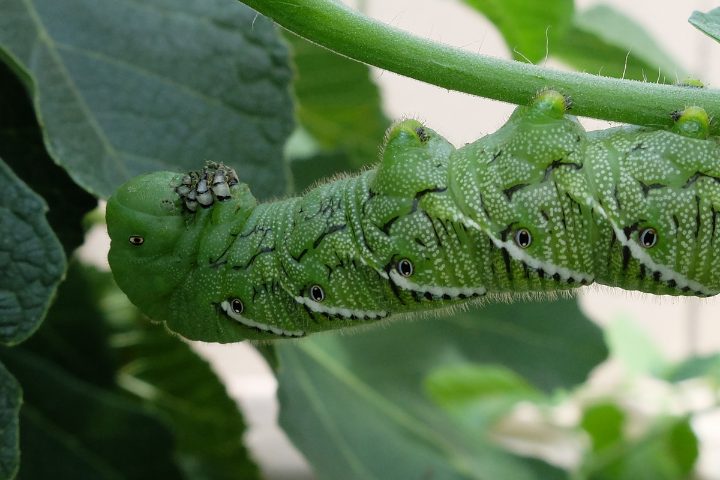Raising hornworms to moths can be a fascinating and educational experience. Hornworms are the larval stage of hawk moths, and they can be found on plants such as tomato and tobacco. Here’s a quick step-by-step guides on how to raise hornworms to moths:
- Find hornworm larvae on plants like tomatoes or buy them.
- Place them in a well-ventilated container.
- Feed them fresh tomato or tobacco leaves daily.
- Maintain a warm temperature (around 80-85°F or 27-29°C).
- Add a substrate like soil or paper towel for pupation.
- Wait for pupation, which can take several weeks.
- Monitor pupae closely as they darken before emergence.
- Provide a surface for emerging moths to climb.
- Care for moths, offering nectar or releasing them responsibly.
How to find healthy hornworm larvae?

Finding healthy hornworm larvae begins with selecting the right host plants and ensuring optimal care conditions for these fascinating caterpillars.
Finding hornworm larvae in the wild
Look for hornworm larvae on plants like tomatoes, tobacco, and related species. They are often found on the underside of leaves, as their green coloration camouflages them.
Inspect your garden regularly, especially during warm months when they are most active.
Be gentle when handling them to avoid stressing or damaging the larvae.
Purchasing hornworm larvae from suppliers
Consider reputable online suppliers or local insect breeders. Verify the source’s reputation for healthy and disease-free hornworms.
Moreover, ensure the larvae are shipped in suitable conditions, typically with food and ventilation. In addition, check for any permits or regulations regarding the purchase and shipping of hornworms in your area.
Importance of selecting healthy larvae:
Healthy hornworm larvae are more likely to develop into robust moths. Signs of a healthy hornworm include vibrant green color, firm body, and active movement.
However, avoid larvae with discoloration, spots, or signs of parasitism. Healthy larvae are more likely to pupate successfully and produce viable moths.
What’s the best container for raising hornworms?
The choice of container plays a crucial role in successfully raising hornworms, with options ranging from plastic tubs to mesh enclosures.
Choosing an appropriate container:
Select a container that provides enough space for the number of hornworms you have. Clear plastic or glass terrariums work well for observation. In addition, ensure the container has a secure lid to prevent escapes.
Ensuring proper ventilation:
Adequate ventilation is crucial to prevent mold growth and maintain oxygen levels. Use fine mesh or small ventilation holes in the container’s lid. Monitor humidity levels to prevent excessive drying.
Adding a suitable substrate:
Place a layer of soil or paper towel at the container’s bottom. Furthermore, this substrate helps maintain humidity and provides a suitable surface for pupation. Keep the substrate slightly moist, but not soggy, during the pupal stage.
Maintaining the ideal temperature:
Hornworms thrive in warm temperatures, typically around 80-85°F (27-29°C). In addition, use a heat lamp, heat pad, or ambient room temperature to maintain this range.
Avoid extreme temperature fluctuations, which can stress the larvae and disrupt their development.
How to maintain a daily feeding routine for hornworms?
Establishing a consistent daily feeding routine for hornworms involves providing fresh host plants, monitoring their consumption, and ensuring a clean habitat to support their growth.
Hornworms primarily feed on plants like tomatoes, tobacco, and other solanaceous plants. Tomatoes are a favorite, but they can also eat other solanaceous plants like peppers and eggplants. Moreover, ensure the leaves you provide are free of pesticides and chemicals, as hornworms are sensitive to toxins.
Daily feeding routines:
Hornworms are voracious eaters, so provide fresh leaves daily. Remove any wilted or dried-out leaves promptly to maintain a clean and healthy environment.
However, if you run out of the preferred food source, consider providing an alternative solanaceous plant temporarily.
Removing uneaten leaves to maintain cleanliness:
Hornworms can produce waste that accumulates quickly in their habitat. Regularly remove uneaten leaves and feces to prevent bacterial growth and odors. Moreover, maintain a clean environment to minimize the risk of disease and stress on the hornworms.
How to recognize when hornworms enter the pupal stage?
Identifying the transition of hornworms into the pupal stage is marked by noticeable changes in their appearance, behavior, and the formation of distinct pupation cues.
Recognizing when hornworms enter the pupal stage:
Hornworms typically enter the pupal stage when they reach a certain size and developmental stage. They may stop eating and become less active.
Additionally, look for signs such as color changes, reduced movement, and the formation of pupal cases.
Preparing the substrate for pupation:
Hornworms will pupate either by burrowing into the substrate or attaching themselves to the container’s walls. Moreover, ensure the substrate is deep enough for burrowing, typically a few inches.
However, if they attach to the container, provide a vertical surface like a stick or cardboard for them to climb on.
Maintaining moisture levels during pupation:
Maintain a slightly moist substrate to prevent desiccation during the pupal stage.
Avoid oversaturation, which can lead to mold or bacterial growth. Mist the substrate lightly with water as needed to maintain proper moisture levels.
Monitoring pupae for signs of emergence:
Pupae will remain in this stage for several weeks to several months, depending on factors like species and temperature. Moreover, observe pupae closely for changes, such as darkening or movement within the pupal case.
Be patient and provide the necessary conditions for successful emergence.
How to prepare for the emergence of moth pupae?
As pupae mature and approach the emergence stage, make sure the habitat is undisturbed. Maintain consistent temperature and humidity levels to support a smooth emergence.
Ensure that there is enough room within the container for the moths to fully expand their wings.
Creating a surface for moths to climb:
Place a stick, twig, or piece of cardboard vertically in the container. Moths need a surface to climb on as they emerge from their pupal cases. The moths will use this surface to hang and allow their wings to expand and dry properly.
Observing the moth emergence process:
Be patient and attentive during this phase. Moths will emerge from their pupal cases, often in the evening or night. Avoid disturbing the emerging moths, as they are vulnerable during this time.
Allow them to fully expand and dry their wings before any handling or release.
How to provide moths with a source of nectar?
Offer moths a source of nectar to sustain them. Fresh flowers like petunias, honeysuckle, or daisies can provide nourishment. In addition, make sure the nectar source is pesticide-free to prevent harm to the moths.
Options for keeping moths or releasing them:
Decide whether you want to keep the moths for observation or release them into the wild. However, if keeping them, provide a suitable habitat with proper food and moisture.
If releasing, choose a suitable outdoor location and release them during the evening or night.
Responsible handling and care considerations:
Handle moths gently and with clean hands to avoid damaging their delicate wings. Avoid exposing moths to direct sunlight, as they are typically nocturnal.
Moreover, ensure their habitat is clean and free from contaminants that could harm them.
How to meet the requirements for breeding moths effectively?

To breed moths, you need a male and a female of the same species. Provide a suitable environment for mating and laying eggs.
Be aware of the specific environmental conditions and behaviors required for successful breeding.
Species-specific guidelines for breeding
Different species of moths may have unique requirements for breeding. Research the specific needs of the moth species you are working with. Follow guidelines related to temperature, humidity, and lighting.
Ensuring the health and well-being of moth population
Pay attention to genetic diversity to maintain the health of captive populations. Consider the ethical implications of breeding moths and ensure you have a plan for the resulting offspring. Moreover, promote conservation efforts for endangered or threatened moth species when possible.
FAQ’s:
How do hornworms turn into moths?
Hornworms turn into moths through a process known as metamorphosis. They enter the pupal stage, during which they undergo a dramatic transformation inside a pupal case. Inside this case, the caterpillar’s body reorganizes, and it eventually emerges as a fully grown moth.
How do you take care of hornworms?
To care for hornworms as they transition into moths, provide them with a suitable habitat with proper temperature, humidity, and food. Monitor their pupation, ensure they have a surface to climb when emerging, and provide nectar for adult moths if you choose to keep them.
How long before a hornworm turns into a moth?
The duration of a hornworm’s pupation stage varies depending on factors like species and environmental conditions. Generally, this stage lasts several weeks to several months.
How do you raise a hornworm caterpillar?
Raising hornworm caterpillars involves providing a container with proper ventilation, suitable food (typically tomato or tobacco leaves), and maintaining the ideal temperature (around 80-85°F or 27-29°C). Regularly clean their habitat and ensure they have a substrate for pupation when the time comes.
Can you breed hornworms?
Yes, it is possible to breed hornworms. To do so, you need a male and a female of the same species, a suitable environment for mating and egg-laying, and knowledge of the specific requirements of the particular hornworm species you’re working with.
Do hornworms need water?
Hornworms primarily obtain moisture from the food they consume, so additional water is typically not necessary. However, maintaining proper humidity levels in their habitat is important, especially during the pupal stage, to prevent desiccation.
Final Words
In conclusion, raising hornworms to moths is a captivating and educational journey that offers insight into the life cycle of these fascinating insects.
Furthermore, this process involves several key stages, from acquiring healthy larvae to observing their transformation into moths. Ensuring proper nutrition, maintaining suitable environmental conditions, and understanding the pupation stage are essential for success.
Moth emergence is a remarkable event that requires careful preparation and observation. Once the moths have emerged, responsible care and handling, including providing a source of nectar, become crucial.
For those interested in taking their involvement a step further, breeding moths is an option, but it demands species-specific knowledge and considerations for the well-being of the populations involved.
Ultimately, raising hornworms to moths offers a unique opportunity to appreciate the beauty of nature and contribute to our understanding of these remarkable creatures.

